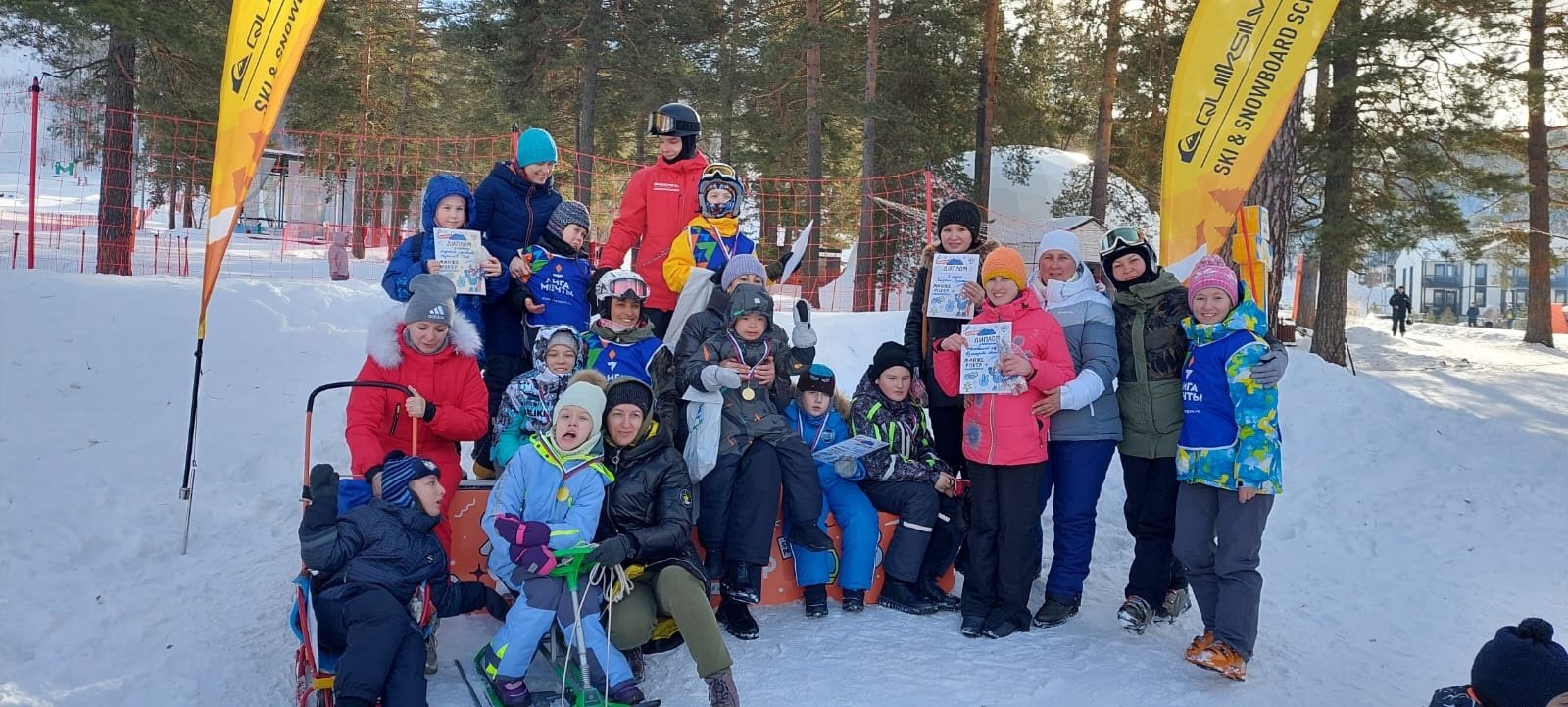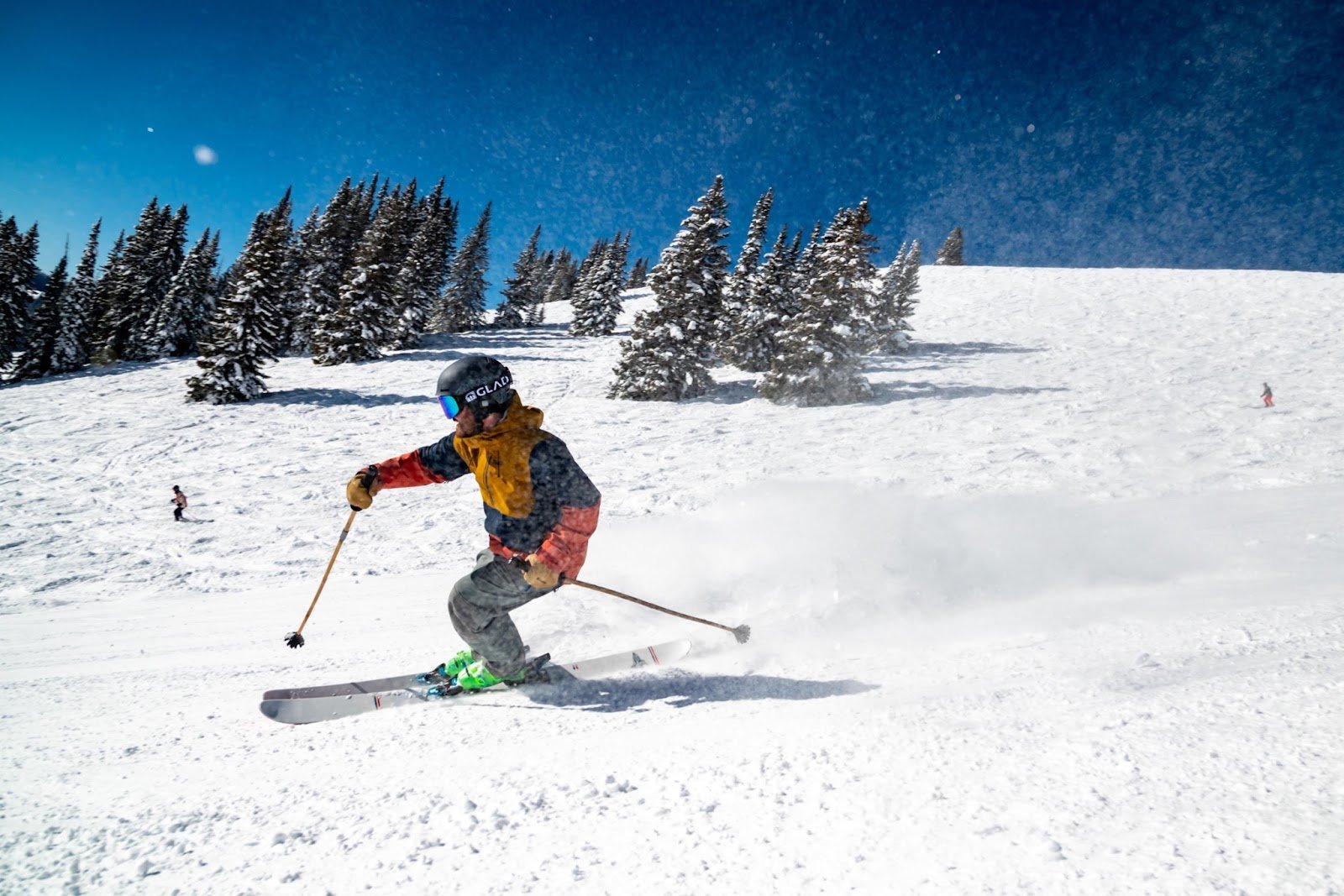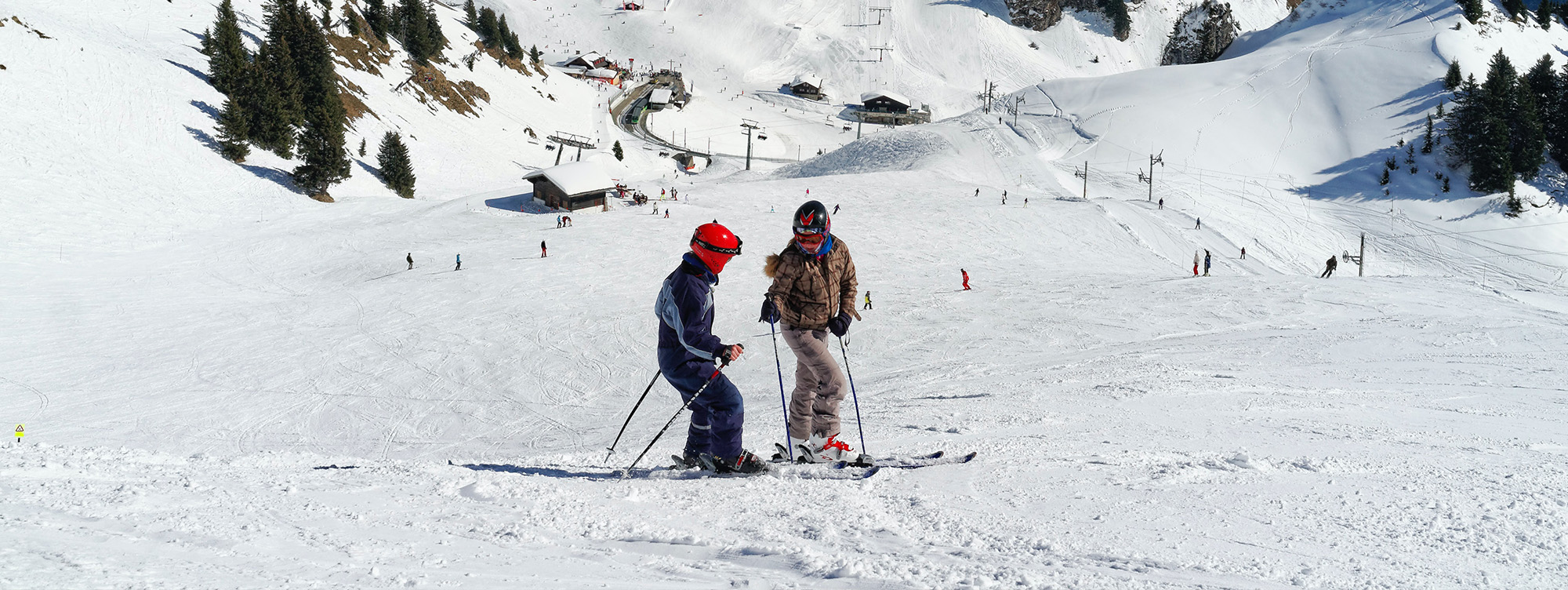While on vacation abroad, Sergey Belogolovtsev, actor and TV show host, and his wife Natalya offered their son Evgeniy diagnosed with ICP to try mountain skiing. The young man was given special equipment and assisted by an instructor. After several training sessions, Evgeniy was able to slide down a trail on his own.
Mountain skiing had an obvious therapeutic effect on him. Sergey and Natalya were so impressed with this discovery that they wished to make such training sessions available in Russia, too. This is how Dream League (formerly, Dream Skis) independent non-profit organization began. Its main goal is the development of mountain skiing for children and adults with disabilities as a way of their rehabilitation and socialization.
Natalya Belogolovtseva, Dream League project director, tells the Special View portal about the project development and sightless persons’ participation in it.

Audio description: a colored group photo of Dream Skis project participants. Children and adults are gathered in the snow under pine trees, between narrow yellow flags fixed to flag poles. All of them are wearing brightly-colored warm clothes, some are holding diplomas, and children have medals on bands around their necks. All are smiling.
How did the Dream Skis project begin and how did you organize your first training sessions?
Dream Skis project was created to help one special child — our son. He was diagnosed with quadriparesis and heart defects, but after two weeks of mountain skiing lessons abroad we were astonished at how much his body changed. It turned out that in unfamiliar conditions of a ski slope it momentarily activated all of its senses, mobilized the spine and the nervous system, engaged its muscle memory, so that after a few sessions our boy could repeat new movements easily.
Sliding down a mountain slope is a stress for the body of a person with physical impairments, but through this very stress, the therapeutic effect is achieved.
The positive results of our son’s mountain skiing lessons were unmistakable, and we wanted to continue such sessions after coming back to Russia. We went to a mountain skiing center closest to our home, explained the situation, said that our son had the basic skills and we would like him to go on practicing, but we were told that it was impossible.
Some time later, in his interview to a well-known periodical, my husband shared this story. The interview was reposted on social networks, and suddenly, very different people began contacting us, including mountain skiing centers directors and coaches.
We’d never planned to run charity projects to develop this sport for children and adults with disabilities, but when we understood that there was quite a number of people enthusiastic about this idea, we began thinking about it.
This was when Anna Shilova joined us, she became our first volunteer. She wrote a business plan for the project, persuaded one of our acquaintances to give USD 20,000 for its development. This money was used to buy special equipment and invite Elizabeth Fox, American expert and director of a national rehabilitation center in Colorado, to consult us. Later on, a part of this sum helped us design our own equipment, train our specialists in America, and organize our training system in Russia. As the result, we were able to build the infrastructure of the project that is now functioning in 45 regions of our country.
Our first downhill skiing training sessions were held in 2014. 9 persons aged 5 to 25 with different forms of disabilities took part in it. Among them, there was a sightless girl with ICP, Darya. When I first saw her, I thought we wouldn’t be able to sign her in — because of such complicated dysfunctions. I was ready to refuse her, but Elizabeth Fox, who was helping us organize our first training sessions, said she would train the girl. Using special equipment Darya managed to stand with her skis on, and she made her first downhill slides in tandem with the instructor. After her body had memorized the movements, Darya was able to slide down unaided, moving in accordance with voice prompts from her coach. Despite our doubts, Darya made it — and afterwards she continued training in our project for a long time.
Are there many sightless persons in mountain skiing? How do they manage to slide down the trail?
I can’t give the exact number of sightless people in the Dream League, but there is quite a bunch of them. We organize their training sessions using individual approach, depending on the gravity of visual impairments, the overall physical condition and any additional health problems.
For a long time, Alina, who had only 5 per cent of her vision, was training with us. She does mountain skiing and roller skating, takes part in competitions and even shows better results than athletes with no physical defects.
In 2014, with the support of the Connection Foundation, we organized training sessions for deafblind persons. One of them was an aged women called Nadezhda, she was completely blind and deaf, and after merely two or three sessions she was able to ski herself! Even for us it was astounding.
If a person has only visual impairments, then they don’t need any special equipment for skiing. They have an instruction session with our expert and do several downhill runs in tandem with the coach, until their body memorizes the unfamiliar movements. After that, a sightless or visually challenged athlete can slide down unaided, adjusting their movements according to voice prompts from the instructor, who is moving along nearby. Of course, all of this takes place on safe gently sloping trails. We have wonderful instructors, who can work with persons with practically any kind of physical defects. But such specialists are few, and the main problem of our project is shortage of such instructors. At the moment, many sightless and visually challenged people are doing mountain skiing in Nizhny Novgorod, and we have only one instructor working with all of them. There are not many experts wishing to train persons with disabilities.

Audio description: a colored photo. A bright winter day. A skier in a colourful suit is sweeping down a low-angled slope. He is wearing a helmet and goggles. He is making a sliding turn, catching his balance, snow powder is flying from under his broad skis.
From the point of view of rehabilitation, what do mountain skiing sessions give persons with visual disability?
Abroad, accessibility of downhill skiing became the result of inclusion development. When a person with disabilities comes to a mountain skiing center, they must be provided the services as well as any other customer, that means that there must be special instructors who know how to work with such guests. Mountain skiing turned out to be an effective way to rehabilitate people with different forms of disabilities, and this is the main focus of our project.
When we were choosing the title for it, one of the options was Skis Are Healing, and I liked it best, because it reflected the project’s main goal. While a person with disabilities is sliding down a trail, their body undergoes a stress and enhances the work of its nervous system which organs functions depend upon, including the functioning of eyesight. I suspect that if a person’s eyesight is impaired because of nervous system’s dysfunctions, then mountain skiing sessions may have a positive effect on their eyesight.
Of course, if our athlete is totally sightless, regular downhill runs will not bring their eyesight back, but they will help develop the coordination skills, improve the overall health, help them react on rapidly changing circumstances more quickly.
Downhill skiing is not the only Dream League program. Could you tell us about other programs visually challenged people can participate in?
That is correct, in addition to mountain skiing, we are promoting the accessibility of roller-skating sport, team games, water sports (SUP boarding, kayaking, para-rafting), rock climbing. Visually disabled persons may take part in any of these programs.
Mikhail, a sightless and hearing impaired person, was very good at roller skating, and Alina I’ve already mentioned is better at it than many people with no disabilities.
In roller sports, there may be problems concerning not the abilities of sightless or visually challenged people themselves, but those who are around them in parks and on roller trails. Colliding with such people may be a threat to athletes with visual impairments, but roller skating training in itself, as well is doing other sports, is quite safe for them.
Roller-skating sessions are held by instructors who are even harder to find that mountain skiing coaches for the disabled. Many sightless and visually impaired people do mountain climbing. This is an accessible sport with good therapeutic effect. As for water sports, they too attract many visually impaired people.
In SUP boarding, kayaking and rafting, a person must learn to coordinate their body, hold the balance, activate all muscle groups. Forming these skills may become an important step in sightless and visually impaired persons’ rehabilitation.
Check our website to find out about the availability of such programs in the disabled person’s region of residence and apply for participation in them.
Signing up for a training session is not that easy: there are not many instructors, and their workload is quite heavy as it is. The sessions are not free of charge. Any labor must be paid for. Teachers and doctors are working for a wage, so the instructors must not work for free. In some regions, the sessions for people with disabilities may be paid for using grants and subsidies. For example, in Khanty-Mansiisk autonomous district, mountain skiing sessions are recognized as part of an individual rehabilitation program, so people with disabilities rehabilitate through mountain skiing for free. But paying for everyone’s training is not our priority. It is more important for us to create suitable conditions for such training, making it possible in general.
Do athletes with visual impairments take part in downhill skiing competitions? How can this influence their socialization?
We are not aiming at professional sports and setting records, but nevertheless, we have athletes with disabilities who take part in professional competitions and win top places.
From time to time, we hold our own Dream Starts National Competitions in all sports; and sightless and visually challenged athletes participate in them, too.
Perhaps, professional athletes would call our competitions a festival, but children and adults with disabilities are quite serious about participating in them. The main goal of the Dream Starts is not defining the winners, but giving athletes with disabilities crucially important skills: help them learn to win and to lose.
We have three top places, but at the same time, all of our competitions participants are winners, so every one of them gets a cup. Imagine a boy with disability who lives in a village where everyone is bullying him. Imagine him coming home with a cup from Dream Starts — after that the attitude of people to him changes a lot. This is important both for him and his family.
As an organization, what would you like to change in Russian rehabilitation system for persons with disabilities?
An important task is to change the overall approach to rehabilitation, to give people rehabilitation through sports instead of one through medical treatment. Rehab through sports is more functional, it is aimed at bringing all the family of an adult or a child with disability back to the society.
If a child with disability starts doing sports, soon their siblings with no health dysfunctions join them too, and later on, their mothers and fathers. A father takes his boy or girl not to a clinic, but to a training session, sees his child not as a “broken piece” but as a partner.
Single moms of disabled children are getting enthusiastic about their child’s activities, change their way of life, start traveling and taking interest in the world around them. One of our project participants is a deafblind boy Dimarik, who, in addition to that, is moving around in a wheelchair. His mom was very anxious when she ventured out with him for one of our Dream Starts for the first time. For her, such journey to another city on a connection flight was a major stress. And now look at her: she has been to all of the corners of the country, she takes much pleasure in traveling, does mountain skiing and roller skating herself.
Families of our athletes with disabilities go visiting each other, and this is a special type of tourism, we call it a family inclusive sport sessions. And to our mind, such sessions should replace traditional courses of health resort treatment which a person with disabilities may await for years and years.


